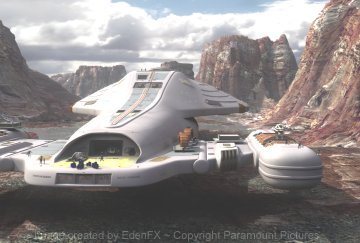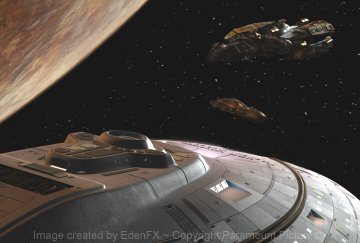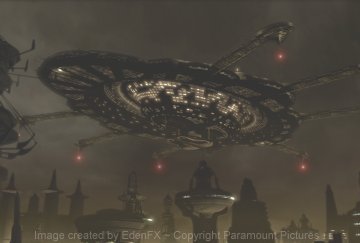LCARSComNet: I'm here, courtesy of the Internet, with John Gross, one of the owners of Eden FX. Eden FX, along with Foundation Imaging, is one of the CGI teams working on ENTERPRISE.
John, tell us a little about what your company Eden FX does and where you are located...

John Gross: My partner, Mark Miller and I formed Eden back in July of 2000, shortly after my former company Digital Muse, had a hostile takeover and went out of business.
Eden FX is located in Hollywood, just minutes away from Paramount. This makes it extremely convenient when we need to go on set, etc.
LCN: So, are you all Star Trek fans? This must be a dream job for you guys. When did you first start working with Star Trek, and how did that come about?
JG: I grew up when TOS was on the air, so it was an enjoyable part of my life as a kid. I wouldn't consider myself a Star Trek fanatic by any means, but I have always watched the shows on and off. When you work on the shows as much as we do, you can't help but know a lot of data that is normally reserved for "die hard" fans... ship registries, histories, etc. I would wager to say that we're all fans, but not fanatics.
I first starting work on Star Trek near the end of Next Generation when I was working at Amblin Imaging creating effects for seaQuest. I met David Stipes (a Trek Effects supervisor) at a NewTek party in Kansas, and he was really into CG. At the time Trek did very few CG effects. He and Dan Curry (Trek Effects Producer) came to Amblin and we were hired to create a sentient lifeform (looked like a bunch of bicycle tubes) for an episode.
A short time after that, the Voyager pilot got underway, and David Stipes really pushed for CG to be involved. There were some shots in the pilot that they needed to have CG for, and so they decided to build a CG Voyager. We spent a few months doing tests and convincing them that we could match the Star Trek look, and finally they awarded a number of shots to us. I was Amblin's CG supervisor for the pilot and oversaw the creation of the CG Voyager.

LCN: You've worked on both Deep Space Nine and Voyager - can you tell us what you enjoyed best from each of the two shows?
JG: From DS9, I think I enjoyed the last season the most... When we did a lot of fleet battles and ship destruction. The final story arc was very fun, and we were involved a lot with the visuals.
Voyager had a number of fun things. We built a *lot* of alien ships for Voyager over the years. I enjoyed getting to see the Voyager land, although those legs always looked like they would break off! Foundation did that great snow crash for Timeless and the underwater stuff we did for Thirty Days was fun.
LCN: How many different ships did you render for DS9? for Voyager?
JG: Yikes! That's a hard one to answer. A lot! I would guess that DS9 was probably around 30-40. Voyager was probably around 50-60. Of course, different ships were often modified and reused as new alien ships as well.
LCN: How long, on average, does it take to create a new CGI ship?
JG: It depends on the complexity, of course, but on average anywhere between 2-4 weeks.
LCN: Can you break down the process for us, in laymen's terms?
JG: If we get a design from the Trek Art Department, we might get just a 3/4 perspective drawing, or we may get all sides. It really depends on whether the ship is a "hero" (one that will be seen a lot and close up) model or not. At that point, the artist assigned to modeling it will start breaking it down into its basic shapes and start creating it in the computer. Sometimes they'll start with a shape that is close (like a box) and start adding geometry and reshaping it to fit. Sometimes, they will have to create it polygon by polygon. Once the geometry is created, then it has to be surfaced to look real. This is where we'll add weathering, decals and the like to make it look like a real vessel.

For almost all of the ships we built for DS9, there was an existing practical model to begin with. In the beginning of Voyager, there were existing models, but by the end, everything was CG. For the new series, Enterprise, everything will be CG.
If a practical model does exist, that model will generally get delivered to us so we can have the real thing there to base the CG version upon. This was a lot of fun for DS9, because a lot of real models came through our shop. Things like the Reliant and Enterprise-A from Wrath of Kahn, The Defiant, the Excelsior, Ferengi ships and Cardassians, At one point, I think we had about 8 models in house as we were building the CG fleet for DS9.
LCN: Now, you don't just do ships. What else do you guys do for the shows?
JG: You name it... special effects, characters, energy fields, anomalies, weapons, stars, planets, set extensions, alien cities, parts of ships that weren't built for real. The list goes on and on.
LCN: How long does it take to do that?
JG: Again, it depends on the complexity of the scene. Generally, we will have anywhere from three to eight weeks for a typical episode. That episode may have anywhere from a dozen to a hundred or so effects shots. Typically, we'll have between 2 and 6 artists working on any given episode.
LCN: Voyager's intro was part CGI and part physical model -- has it been established yet what ENTERPRISE's intro will be? (I am assuming you guys will be handling it -- let me know if I'm wrong.)
JG: From what I've heard, the intro for Enterprise is going to be a bit different. I can't really say anything about it, but it is not being done by us or Foundation.
LCN: I realize ENTERPRISE is still four months away from airing, but what have you done so far (that you can tell us)?
JG: We've been doing a lot of R&D and have starting working out shots. Most of the shots that we are doing involve live action plates, so we are waiting for all the shooting to be done, so we can get the footage and really pound away!
LCN: What do you have yet to do?
JG: We have a lot of set extensions (adding CG elements onto a real set) and a lot of shots involving live action plates that we need to add CG to.
LCN: ENTERPRISE is set about two centuries before TNG/DS9/VGR. Do you find it a challenge to create a "retro" look while still trying to come up with a futuristic look?
JG: Yea, it's a lot of fun actually. The challenge is to make it cool and new, yet something that could be a "predecessor for what we know will be coming down the road. We also have to take advantage of the fact that we have the means of creating things that couldn't be done at the time of the other shows, yet keep it all within the Star Trek world. It's very challenging.
LCN: Tell us a bit about what you are doing with the cast (re the 3D modeling of them).
JG: The entire main cast has been scanned so we can create 3D models of them. This will give us the ability to do all sorts of fun things with them and create really great shots. I can't say what you'll be seeing, but expect some great shots over the run of Enterprise!
LCN: What's the biggest challenge you've faced so far for ENTERPRISE?
JG: I think it's trying to come up with the look for certain things that are better than what we've seen before, but can still be explained as earlier technology.
LCN: John Eaves (& co.) helped design the new Enterprise, so what will you be given to CGI it?
JG: Foundation is actually building the ship, but what they'll receive is drawings from all different angles in order to create in the computer what John has created on paper.
LCN: Over 90% of the Next Generation's ships were physical models -- do you know how will that translate for ENTERPRISE?
JG: I think we'll find that most, if not all, of the ships seen in Enterprise will be CG.
LCN: Lastly, do you have any job openings?
JG: Ha! Depending on how big the shows are for Enterprise, most likely!


![]()


![]()